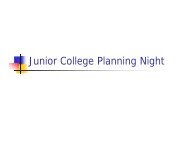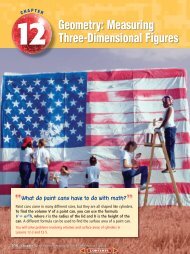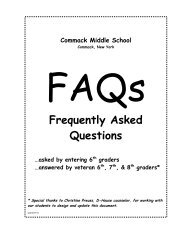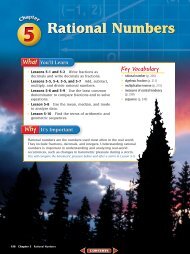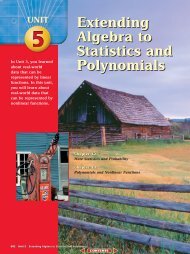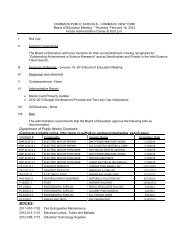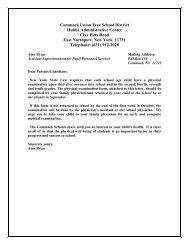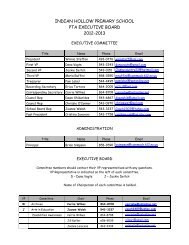Preparing for the Regents Examination Geometry, AK
Preparing for the Regents Examination Geometry, AK
Preparing for the Regents Examination Geometry, AK
Create successful ePaper yourself
Turn your PDF publications into a flip-book with our unique Google optimized e-Paper software.
9-5 The Sum of <strong>the</strong><br />
Measures of <strong>the</strong> Angles<br />
of a Triangle<br />
(pages 193–195)<br />
1 (4) scalene<br />
2 (3) obtuse<br />
3 (3) 120<br />
4 (2) right<br />
5 (3) 112<br />
6 a base angles are 30, vertex angle is 120<br />
b base angles are 60, vertex angle is 60<br />
c base angles are 52, vertex angle is 76<br />
d base angles are 36, vertex angle is 108<br />
e base angles are 20, vertex angle is 140<br />
7 a base angles are 50, exterior angle is 130<br />
b base angles are 40, exterior angle is 140<br />
c base angles are 54, exterior angle is 126<br />
d base angles are 60, exterior angle is 120<br />
e base angles are 80, exterior angle is 100<br />
8 base angles are 74, vertex angle is 32<br />
9 mP 27, mQ 45, mR 108<br />
10 base angles are 28, vertex angle is 124.<br />
11 exterior angle is 30, base angles are 15,<br />
vertex angle is 150<br />
12 18, 54, 108<br />
13 99, 45, 36<br />
14 mc 35<br />
15 mB 78<br />
16 mx 150<br />
17 mx 30<br />
18 m1 150<br />
19 mD 20<br />
20 md 125<br />
Note: Since <strong>the</strong>re are many variations of proofs,<br />
<strong>the</strong> following is simply one set of acceptable<br />
statements to complete each proof. Depending<br />
on <strong>the</strong> textbook used, <strong>the</strong> wording and <strong>for</strong>mat<br />
of reasons may differ, so <strong>the</strong>y have not been<br />
supplied <strong>for</strong> <strong>the</strong> method of congruence applied<br />
in each problem. (These solutions are intended<br />
to be used as a guide—o<strong>the</strong>r possible solutions<br />
may vary.)<br />
21 1. A C<br />
2. ___<br />
BD bisects ABC.<br />
3. ABD CBD<br />
4. ___<br />
BD ___<br />
BD<br />
5. ABD CBD (AAS AAS)<br />
48 Chapter 9: Parallel Lines<br />
6. ADB CDB (CPCTC)<br />
7. ADB is supplementary to CDB.<br />
8. ADB and CDB are right angles.<br />
9. −−<br />
BD −−<br />
AC (Segments <strong>for</strong>ming right<br />
angles are perpendicular.)<br />
22 1. A C<br />
2. ___<br />
BD ___<br />
AC<br />
3. BDA and BDC are right angles.<br />
4. BDA BDC<br />
5. ___<br />
BD ___<br />
BD<br />
6. BDA DBC (AAS AAS)<br />
7. ABD CBD (CPCTC)<br />
8. ___<br />
BD bisects ABC. (Definition of angle<br />
bisector)<br />
23 Both ABC and DEC share C. Since <strong>the</strong><br />
remaining angles are <strong>the</strong> same as well, 1<br />
and B are congruent corresponding angles.<br />
There<strong>for</strong>e, ___<br />
BA ___<br />
ED .<br />
24 Compare ABC and DEC. Both are right<br />
triangles with one pair of congruent acute<br />
angles. There<strong>for</strong>e, <strong>the</strong> o<strong>the</strong>r pair of acute<br />
angles are also congruent, B CED. But<br />
CED 1, vertical pairs. Then B 1<br />
by <strong>the</strong> transitive postulate of congruence.<br />
9-6 Proving Triangles<br />
Congruent by Angle,<br />
Angle, Side<br />
(pages 198–200)<br />
1 b and f<br />
2 a Not sufficient. If <strong>the</strong> third side is congruent,<br />
SSS. If included angles are congruent,<br />
SAS.<br />
b Sufficient, SSS<br />
c Sufficient, hypotenuse-angle<br />
d Not sufficient. If ei<strong>the</strong>r pair of corresponding<br />
angles are congruent, AAS.<br />
e Sufficient, AAS<br />
f Not sufficient. If any pair of corresponding<br />
sides are congruent, AAS.<br />
g Sufficient, hypotenuse-leg<br />
h Sufficient, SAS




